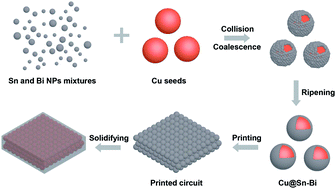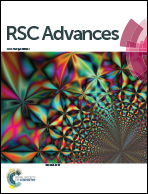Facile fabrication and low-temperature bonding of Cu@Sn–Bi core–shell particles for conductive pastes†
Abstract
The rapid development of flexible wearable electronics arouses huge demand for low-temperature sintering metal inks applied to temperature-sensitive substrates. The high sintering temperature and easy oxidation limited the application of Cu-based pastes. A two-step method involving liquid co-reduction and heat ripening was developed to synthesize Cu@Sn–Bi core–shell particles. The thickness of Sn–Bi shells can be flexibly adjusted via changing the mass ratio of Cu to Sn–Bi. The volume resistivity of printed circuits using Cu@Sn–Bi pastes solidified at 200 °C was as low as 481 μΩ cm, which increased by 11.8% after an aging process at 190 °C for 6 h. The outstanding stability in a harsh environment would attribute to the effective protection of Sn–Bi alloy shells. This work suggests a new pathway toward the low-temperature bonding and anti-oxidation of Cu particles as conductive fillers, which can be widely applied to the additive manufacturing of flexible wearable electronics.



 Please wait while we load your content...
Please wait while we load your content...